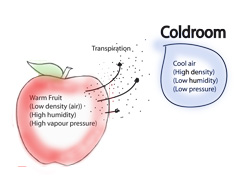At this time when all growers are immersed in harvest and readying their crop for cold storage I thought it might be useful to revisit the issue of moisture loss of harvested fruit in storage.  Probably the first thing to understand when addressing this issue is that of humidity.
Probably the first thing to understand when addressing this issue is that of humidity.
Humidity is the measure of water vapour within the air. Humidity is always quoted in percentage terms of relative humidity. But this percentage doesn’t tell the full story.
Humidity, air density, air temperature and water vapour pressure are all interactive.
Relative humidity is the amount of moisture in the air compared to what the air can ‘hold’ at that temperature. When the air can’t ‘hold’ all the moisture, then it condenses as dew.
That is a simple explanation for something which is correctly defined as the ratio of the partial pressure of water vapour in the air-water mixture to the saturated vapour pressure of water at those conditions.
That is quite hard to understand, but suffice to say, relative humidity of air depends not only on temperature but also on relative pressures of the air/water mix.
Warm air molecules can ‘absorb’ more water than cold air molecules. Antarctic air is very dry and very dense, but tropical air is moist and less dense.
As the air molecules warm and expand they become excited and in doing so, increase saturated vapour pressure in the air and thus the ability of the air to ‘hold’ water is increased.
So one can see now that actual percentage of relative humidity does not always equate to the actual quantity of water in the air, but is dependent on other factors as well.
We have all heard incredible quotes of humidity in the tropics being at 90% whilst the temperature is 30C+ degrees and such like. Often this is just exaggeration as the percentage of humidity may actually not be nearly that high, but certainly feels it given the higher amount of actual water held in the warm atmosphere.
How does this relate to fruit storage?
When harvested fruit is brought in from the field it is generally warm and there is also high vapour pressure (concentration) within the fruit.
Usually, growers seek to put the fruit into cold storage quickly. Inside the cold storage the cold air is quite dry and as a result also has low water vapour pressure.
When the warm fruit is placed within the cold storage, the air coming into immediate contact with the fruit warms too. This warming creates a change in pressure as the air molecules expand and further, the expanding air molecules now have increased ability to absorb moisture.
The closest source of that moisture is within the fruit. That warming air actually draws moisture through the skin of the fruit (transpiration) until the temperature of the fruit and the outside coolroom air (and hence vapour pressure) is equalised.
Warm air at 30C can contain 6.5 times more water vapour than air at 0 C. So one can easily imagine when considering all the air in the coolroom how much water could transpire from the fruit.
Importantly, once transpired there is little re-absorption of the lost moisture.
So how can a grower combat this effect?
The trick is to reduce the equalisation time, but realise that some transpiration will still occur regardless.
However try to:
- Harvest fruit early in the day when the air temperature is lower—this reduces the equalisation time.
- Use an efficient pre-cooler to bring the fruit temperature down to storage temperature as quickly as possible—this also reduces equalisation time.
- If no pre-cooler is available, place warm fruit under a sprinkler overnight to cool the fruit (saturating the bins and surface of the fruit also provides another source of water during the equalisation).
- Covering the bins with plastic until temperature equalisation occurs—limits the transpiration (however, observed condensation inside the plastic cover indicates this is only partially successful).
- Keep storage rooms as humid as possible, but be aware that there is a limit to how much water the cold air can absorb.
Many growers know that in flooding the floor of a coldroom often sees pools of water remaining seemingly forever (this last method will have almost no affect if the fruit temperature is not equalised quickly).
Reference: R.Barclay—Australian Bureau of Meteorology, Kent



















